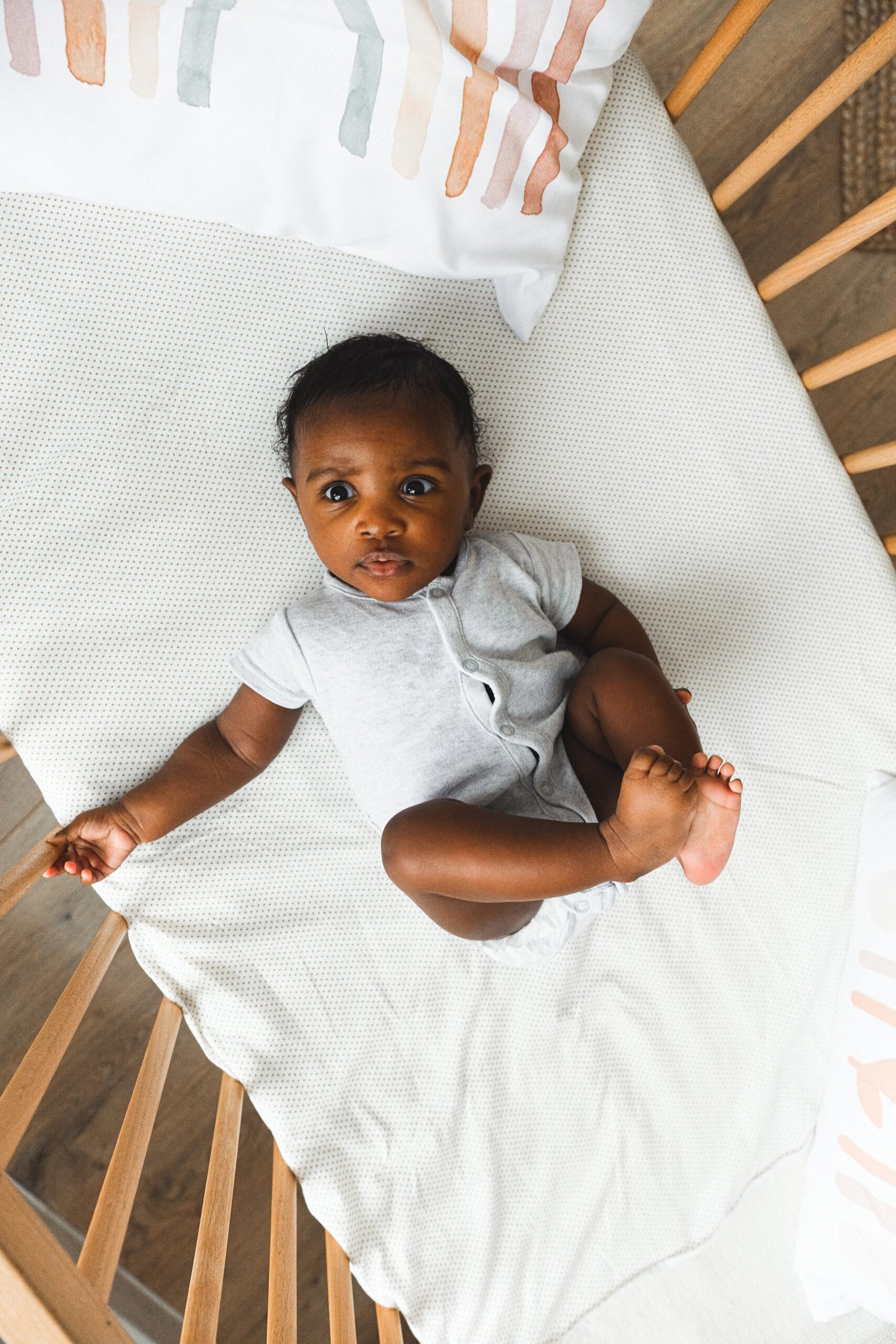I'm Rachael
Mom of 3 & Baby Sleep Expert with Big Sis Energy
& I’VE DONE ALL THE RESEARCH FOR YOU ALREADY.
Better sleep for the entire family
BROWSE COURSES
hey!
benefits of responsive caregiving: the research
in this post:
We all hear terms like “responsive parenting” or “gentle parenting” but what do these terms really mean? Today I’m going to break down what we actually mean by “responsive caregiving” and what the benefits are (hint: they are endless!) so you can feel confident in the way you’re choosing to parent your child. I’ll also discuss responsiveness and the research as it pertains to sleep in particular.
What does it mean to be responsive?
Responsive caregiving involves observing and understanding your child’s cues and responding to their needs in a timely and appropriate manner. It is characterized by sensitivity, warmth, and attentiveness. This caregiving style contrasts with more rigid, schedule-driven, and behaviorist or “authoritarian” approaches, emphasizing flexibility and responsiveness to each child’s unique needs.
Why is it important to be responsive in our caregiving?
We all want to raise children that are well-adjusted, happy and confident. One of the most effective ways to foster your child’s development is through responsive caregiving. Research shows that this approach has profound benefits for babies and young children, shaping their cognitive, emotional, and social well-being. Let’s explore what responsive caregiving is and why it is so vital:
-
Promotes Secure Attachment
Responsive caregiving helps build a secure attachment between parent and child. When caregivers consistently respond to their child’s needs, it fosters a sense of trust and security. A study by Ainsworth et al. (1978) highlighted that secure attachment forms the foundation for healthy emotional and social development. Children who feel secure are more likely to explore their environment, develop independence, and form healthy relationships later in life .
-
Enhances Development
Early interactions with caregivers play a critical role in brain development. Responsive caregiving stimulates neural connections through activities such as talking, reading, and playing with the child. Research from the Harvard Center on the Developing Child indicates that these positive experiences can significantly enhance cognitive abilities, including language development and problem-solving skills. Increased maternal responsiveness facilitated greater growth in target infants’ social, emotional, communication, and cognitive competence, supporting a causal role for responsiveness on infant development.
-
Supports Emotional Regulation
Children who receive responsive care learn to manage their emotions more effectively. When caregivers respond calmly and supportively to a child’s distress, it teaches them how to cope with difficult emotions. A study by Gunnar and Quevedo (2007) found that responsive caregiving helps regulate stress hormone levels, contributing to better emotional health and resilience .
-
Encourages Social Competence
Through responsive interactions, children learn essential social skills. They observe and mimic caregivers’ behaviors, learning how to communicate, share, and empathize with others. According to the National Scientific Council on the Developing Child (2004), these early social experiences are crucial for developing interpersonal skills and forming positive relationships throughout life .
-
Reduces Behavioral Problems
Children who experience responsive caregiving are less likely to develop behavioral issues. Consistent and sensitive responses to their needs can reduce frustration and promote a sense of security. Research published in the Journal of Child Psychology and Psychiatry found that children with responsive caregivers exhibited fewer behavioral problems and higher levels of social competence.
-
Buffers Stress and Protects Future Health
Parenting interventions that promote greater sensitivity may help children in high-stress environments avoid negative adult health outcomes. Specifically, individuals who experienced higher stress but also received more maternal sensitivity during childhood had equally good health outcomes as did those who experienced lower stress at both stages and received higher maternal sensitivity, revealing the significance of early relationships on adult health outcomes.
Practical Tips for Responsive Caregiving
-
Be Present and Attentive: Spend quality time with your child, free from distractions. Focus on their needs and signals. It can be hard to give 1:1 undivided attention every day with our busy schedules, especially if we have multiple children, but it’s so important! Bedtime is a great way to squeeze in some connecting time, and can help with sleep as well.
-
Follow Your Child’s Lead: Engage in activities that interest your child. Allow them to guide playtime and exploration. You don’t need to play with your child regularly (independent/ self directed play is important for development too!) but when you do engage, try to avoid leading the show.
-
Respond with Sensitivity: Address your child’s needs promptly and with empathy. Show that you understand their feelings and are there to support them.
-
Encourage Exploration: Provide a safe environment for your child to explore. Support their curiosity and be there to guide them without giving into the temptation to “hover” or “helicopter parent.” Children need exploration just as much as they need connection with us in order to establish a secure attachment.
-
Communicate Openly: Talk to your child often, even if they are too young to respond. Narrate your activities, read and sing to them, and encourage two-way communication. This means making eye contact and engaging in back-and-forth or “serve and return” interactions often.
-
Co-regulate during times of Distress: We can co-regulate with our infants by:
-
responding to your baby in an empathetic and consistent way when they are upset
-
validating and naming their emotions
-
narrating what’s happened to make them upset
-
showing them with your face- matching your face with theirs to show that you understand they’re distressed
-
holding them close, especially chest to chest or cheek to cheek
-
swaying, rocking, or other movement
-
softly talking, humming or singing to them
-
stroking their back or head
-
simply holding them and waiting for them to calm down, taking deep breaths
-
remaining calm and regulated yourself
-
What are the benefits of responsiveness when it comes to infant and child sleep?
When it comes to choosing an approach to baby sleep, there are a lot of opinions out there! Many baby sleep philosophies are rooted in behaviorism, which is where ideas like “cry it out” come from. There are many people who still believe that babies need to be “conditioned” or “trained” to need their parents less, to become more independent more quickly, etc. We know these ideas are actually counterintuitive, but change takes time!
Fortunately we do know from the mountains of evidence on the benefits of responsive caregiving, attachment theory etc., that ALL children do well with sensitive and responsive caregiving. This includes warmth, sensitivity, and responsiveness before and during sleep time. Here are some of the ways that we see responsiveness actually foster better sleep:
-
Establishing a Sense of Security
Responsive caregiving helps establish a secure attachment between the child and caregiver, which is crucial for healthy sleep. A secure attachment means that the child feels safe and comforted, which can reduce anxiety and promote better sleep. A study by Sadeh et al. (2010) found that infants with secure attachments had fewer sleep problems and more consistent sleep patterns compared to those with insecure attachments .
-
Regulating Stress and Emotions
Sensitive caregiving helps regulate a child’s stress and emotions, which can significantly impact sleep quality. When caregivers respond calmly and soothingly to their child’s needs, it helps reduce stress hormones like cortisol. Elevated cortisol levels are associated with sleep disturbances. Research by Mindell et al. (2017) showed that responsive caregiving practices, such as consistent bedtime routines and sensitive responses to nighttime awakenings, were associated with better sleep outcomes in infants .
-
Creating Consistent Bedtime Routines
Responsive caregivers often establish and maintain consistent bedtime routines, which are known to improve sleep quality. A predictable bedtime routine helps signal to the child that it is time to sleep, making the transition smoother and reducing resistance. Research by Mindell and Williamson (2018) indicates that consistent bedtime routines are linked to earlier bedtimes, reduced sleep latency, and fewer night wakings .
-
Promoting Self-Soothing Skills
Through responsive caregiving, children eventually learn to self-soothe, which is helpful for falling asleep and returning to sleep (or “connecting sleep cycles”) during the night. When caregivers provide comfort and reassurance, children gradually become more able to settle themselves in the absence of their caregiver. A study by Adams et al. (2014) found that infants who received consistent and sensitive responses from their caregivers were more likely to develop effective self-soothing strategies and exhibit better sleep consolidation over time .
Practical Strategies for Promoting Healthy Sleep Through Responsive Caregiving
-
Observe and Respond to Sleep Cues: Pay attention to your child’s “sleepy cues” or signals that they are tired, such as rubbing eyes, yawning, or becoming fussy. Respond promptly by initiating the bedtime routine or providing comfort.
-
Create a Connecting Bedtime Routine: Establish a consistent and calming bedtime routine that includes activities like bathing, reading, and cuddling. This routine helps signal to your child that it is time to wind down and prepare for sleep.
-
Provide Comfort During Night Awakenings: When your child wakes up during the night, respond with calm and gentle reassurance. Offer a cuddle, stroke their back, or offer a feeding to help them stay calm and connect sleep cycles.
-
Regulate Yourself First: Research finds that Infants with mothers who were scored as more emotionally available (EA) at bedtime, showed less infant distress and more sleep (coded through videosomonography, where the infant’s sleep–wake states were objectively assessed), as well as lower infant salivary cortisol levels, as compared to those with lower EA mothers. This means that we may get better sleep if we’re able to remain calm and emotionally available during bedtime.
Responsive caregiving is a powerful tool that shapes your child’s future. By being attentive, sensitive, and supportive, you help your child develop the skills and confidence they need to thrive. The benefits of this approach are well-documented, providing a strong foundation for your child’s cognitive, emotional, and social development. The best part is- you’re probably already doing much of this. By being here, you’re already showing up as a loving and attentive parent who wants to do right by your child- and that’s an incredible gift!
References
-
Ainsworth, M.D.S., Blehar, M.C., Waters, E., & Wall, S. (1978). Patterns of Attachment: A Psychological Study of the Strange Situation. Erlbaum.
-
Harvard Center on the Developing Child. (n.d.). Brain Architecture. Retrieved from developingchild.harvard.edu
-
Gunnar, M.R., & Quevedo, K. (2007). The neurobiology of stress and development. Annual Review of Psychology, 58, 145-173.
-
National Scientific Council on the Developing Child. (2004). Young Children Develop in an Environment of Relationships. Retrieved from developingchild.harvard.edu
-
Belsky, J., & Fearon, R.M.P. (2002). Infant-mother attachment security, contextual risk, and early development: A moderational analysis. Development and Psychopathology, 14(2), 293-310.
-
Sadeh, A., Tikotzky, L., & Scher, A. (2010). Parenting and infant sleep. Sleep Medicine Reviews, 14(2), 89-96.
-
Mindell, J. A., Sadeh, A., Kwon, R., & Goh, D. Y. T. (2017). Relationship between child and maternal sleep: A developmental and cross-cultural comparison. Journal of Pediatric Psychology, 42(8), 825-836.
-
Mindell, J. A., & Williamson, A. A. (2018). Benefits of a bedtime routine in young children: Sleep, development, and beyond. Sleep Medicine Reviews, 40, 93-108.
-
Adams, E. L., & Rickert, V. I. (2014). Reducing bedtime tantrums: Comparison between positive routines and graduated extinction. Pediatrics, 133(6), e1664-e1671.
Featured
Choosing the right time to leave your baby is a super personal choice. Some babies and moms feel comfortable at a much earlier stage than others and finding the right time for you is important. These are my tips for prepping to leave your baby overnight.
Travel crib and play yards can provide a safe and comfy space for your little one to hang out or sleep. But which travel crib is best? In this blog post, Rachael reviews 6 different popular play yards and compares each one based on different criteria…
binge reads
We think you'll love these
You deserve to the
baby stage, not just "survive it."
And you DON'T have to sacrifice your values, ignore your instincts, or force yourself to follow a method you don't align with just to get your baby back to sleep.
I’m here to help you create a restful, sustainable sleep environment that honors both your baby’s needs AND your own (without the stress OR the guilt!) because, no, you don’t have to choose between the two.
enjoy!
BABY SLEEP COURSES →
BABY SLEEP CONSULTS →
Wish you could help your baby sleep better without resorting to sleep training? Download my FREE guide to a good night’s sleep and learn 8 simple, science-backed tips for supporting your child’s needs.
Traditional sleep training methods don’t have to be your solution to better sleep.
SLEEP TRAINING ISN’T THE ONLY WAY TO GET GOOD SLEEP
Hey, I'm Rachael and Hey, Sleepy Baby is for parents who want to get their nights back, without sleep training their babies.
NO ONE TOLD US POD
explorING the untold truths of parenting





